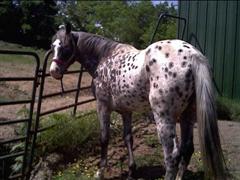Walkaloosa
Palomino
Fri, 22nd November, 2024 - 11:13 am GMT
Sponsor Ads:

Alternative Name
PalominoBasic Info
Walkaloosas come in many shapes and sizes...the smooth natural gaits and colorful coat patterns make this animal quite unique. Their heads bay be straight or slightly dished, and their eyes are ringed with white sclera and are large and kind and widely shaped. They should not have a coarse head Roman nose; their muzzles should be clean and fine. Their skin should also be mottled around the eyes and lips. Their necks should be well set on their shoulders and medium to long in length. Their throatlatch should be well defined and the neck slightly arched. The shoulders should have good depth through the girth, and their chests should be moderately wide and well muscled but not muscle bound. Their withers should be well defined but not pronounced, and the back relatively short and strong with a slightly sloping croup. Their tails are well set and carried with an air of grace, and the legs are straight, clean, and flat boned. Extreme fineness in the bones is not desirable, and the hooves are stripes and well suitable to carry the horse's weight. The Walkaloosa stands from 13 to 17 hands, 14.2 to 15.3 hands being the most typical heights. They weigh anywhere from between 600 to 1,300 pounds and can be either stout or refined in stature.
Health
N/AHabitat
N/ABehavior
They are typically colored like the Appaloosa horse and are kind, gentle, and willing, which makes them suitable for amateurs. They are outstanding pleasure and trail mounts and are also used for field trials, range work, cattle work, and in showing.Origin
Prehistoric ice caves of FranceHistory
Although the Walkaloosa Registry is fairly new, the Walkaloosa horse has been around for centuries. Appaloosa breeders claim to have the oldest recognizable breed known to man - a claim backed by drawings of spotted horses in the prehistoric ice caves of France. Paso Fino breeders consider their breed to be the oldest breed in the Western Hemisphere. The ancestors of the Paso Fino came to the New World with Columbus on his second voyage from Spain. Paso Fino literally translated is "smooth gait". The Paso Fino horses were the preferred mounts of the Conquistadors. Some of their Fino horses also carried the spotted coat patterns of what is known as the Appaloosa today. As horses made their way North, the Nez Pierce Indians eventually claimed them. The Nez Pierce were one of the only tribes to practice selective breeding. They were very proud of their spotted horses and well pleased with what was known as the Indian Shuffle. The Indians could move their households quickly without undo jarring of belongings or rider. Cowboys were said to be willing to pay up to $50.00 more for a "Shuffler". The easy gait saved wear and tear on the cowboy and his gear as it had for the Spaniards and the Indians before him. After the founding of the Appaloosa Horse Club in 1938, the gaited spotted horses were lumped with all other spotted horses and called Appaloosas. Gene Autry owned a gaited Appaloosa, "El Morroco". It is said that he delighted in showing off El Morroco's smooth gait by placing a glass of water on his saddle horn and riding swiftly without spilling a drop. What goes in the show ring is all too often what breeders strive for, and Appaloosa breeders are no exception. An intermediate gait, other than a trot, is cause for disqualification in the Appaloosa show ring. Early breeders did not try to keep the Shufflers in their herds. The Appaloosa Horse Club will, in fact, no longer accept for Registration, any foal with Appaloosa coloring and a parent from a "gaited" breed. With the large percentage of Quarter Horse, Arabian, and Thoroughbred in today's Appaloosas, many breeders have never even heard of a "Shuffler".Common Foods
grassSponsor Ads:
Like its politicians and its war, society has the teenagers it deserves. --J. B. Priestley
Walkaloosa
Coded by: BGID® | ALL RIGHTS RESERVED Copyright © 2000-2024
Disclaimer | Privacy | Report Errors / Contact | Credits










